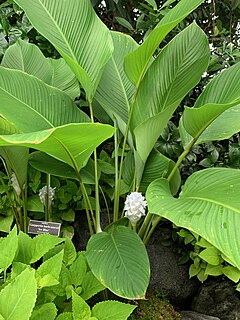
The plant tribe Phaseoleae is one of the subdivisions of the legume subfamily Faboideae, in the unranked NPAAA clade. This group includes many of the beans cultivated for human and animal food, most importantly from the genera Glycine, Phaseolus, and Vigna.

Sterculia is a genus of flowering plants in the mallow family, Malvaceae: subfamily Sterculioideae. Members of the genus are colloquially known as tropical chestnuts. The scientific name is taken from Sterculius of Roman mythology, who was the god of manure; this is in reference to the unpleasant aroma of the flowers of this genus. Sterculia may be monoecious or dioecious, and flowers unisexual or bisexual.

Bignonia is a genus of flowering plants in the family Bignoniaceae. Its genus and family were named after Jean-Paul Bignon by his protégé Joseph Pitton de Tournefort in 1694, and the genus was established as part of modern botanical nomenclature in 1753 by Carl Linnaeus. Species have been recorded from the southern USA, Central to most of South America.

Achimenes is a genus of about 25 species of tropical and subtropical rhizomatous perennial herbs in the flowering plant family Gesneriaceae. They have a multitude of common names such as magic flowers, widow's tears, Cupid's bower, or hot water plant.

Dampiera is a genus of about 70 species of flowering plants in the family Goodeniaceae, all of which are endemic to Australia. Plants in the genus Dampiera are subshrubs or herbs with sessile leaves, flowers with five small sepals and blue, violet or pink, rarely white, two-lipped flowers.
Dischidia is a genus of plants in the family Apocynaceae. They are epiphytes native to tropical areas of China, India and most areas of Indo-China. Dischidia are closely aligned with the sister genus Hoya. Unlike Hoya, the genus Dischidia is poorly known and has not been studied as closely. A few of the species in widespread cultivation, and can be kept as houseplants in temperate regions.

Billardiera is a genus of small vines and shrubs in the family, Pittosporaceae, which is endemic to Australia. The genus was first formally described in 1793 by botanist James Edward Smith who named it in honour of Jacques Labillardière, a French botanist.

Bertiera is a genus of flowering plants in the family Rubiaceae. It comprises 57 species with most known from tropical Africa, five known from various Indian Ocean islands and five found in the tropics of the Americas.

Rothmannia is a genus of flowering plants in the family Rubiaceae. It was described in 1776 and is named for Göran Rothman (1739–1778) by Thunberg – both were pupils of Linnaeus.

Calytrix is a genus of shrubs in the family Myrtaceae described as a genus in 1806. They are commonly known as starflowers. Calytrix are endemic to Australia, occurring in the.
Remijia is a genus of flowering plants in the family Rubiaceae. Within the family, it is a member of the subfamily Cinchonoideae and the tribe Cinchoneae.

Enteropogon is a genus of tropical and subtropical plants in the grass family. It is widespread across many parts of Asia, Africa, Australia, the Americas, and various islands.
Cuviera is a genus of flowering plants in the family Rubiaceae native to tropical Africa. It was originally described by Augustin Pyramus de Candolle in 1807 and is named after the French naturalist Georges Cuvier.

Hermannia is a genus of flowering plants in the mallow family, Malvaceae. It comprises at least 65 species with many more species as yet unresolved.

Markhamia is a genus of flowering plants in the family Bignoniaceae. The genus is named after Clements Markham.

Goeppertia is a genus of flowering plants in the family Marantaceae, native to the New World Tropics. It contains 243 accepted species, many of which were until recently assigned to Calathea. It was first described by Nees von Esenbeck in 1831, who erroneously erected another genus Goeppertia in 1836, which has now been synonymized with Endlicheria. In 1862 August Grisebach described another genus Goeppertia; this has now been synonymized with Bisgoeppertia.
Baissea is a genus of plant in the family Apocynaceae found in tropical Africa. As of August 2013 the World Checklist of Selected Plant Families recognises 18 species:

Coussarea is a genus of flowering plants in the family Rubiaceae. The genus is found from southern Mexico to tropical America.














